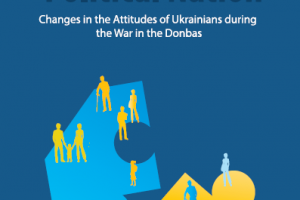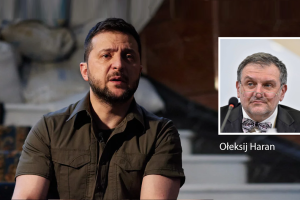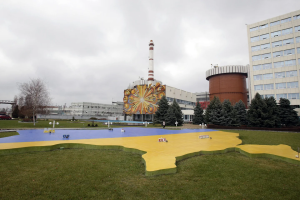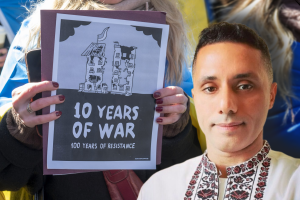Presidential election in Ukraine: Five reasons Zelenskiy is likely to win the second ballot
Ruslan Kermach,
a freelance political analyst
and an associate expert at the Ilko Kucheriv Democratic Initiatives Foundation (DIF) in Kyiv (Ukraine)
What do the trends in the first round of the Ukrainian presidential election tell us about how the second round will look like? With less than a week left to the final contest, both candidates seem intent on continuing to discredit each other.
According to the final counting by the Central Election Commission of all 100 per cent of the ballots, comedian Vladimir Zelenskiy achieved a pretty convincing victory. Gaining a little more than 30 per cent of the votes, he confidently enters the second round of Ukraine’s presidential elections, which are scheduled for April 21.
Zelenskiy’s rival in the upcoming second ballot will be the incumbent President Petro Poroshenko, who managed to snatch a close first round [victory over longtime opposition leader and former Prime Minister of Ukraine Yulia Tymoshenko. According to the results, Poroshenko gained 15,95 per cent of the votes, and is ahead of Tymoshenko with a margin of 2.55 per cent (the latter has 13.4 per cent).
Winners and losers among the campaign favorites
It is worth noting that the Tymoshenko’s close loss to Poroshenko could be in part due to the usage of dirty political technology in this election against the leader of the Batkivshchyna party. A little-known candidate with the same surname and initials as Yulia Tymoshenko — Yuriy Timoshenko — gained 0.62 per cent of the vote, and thus could have taken the votes of either inattentive or elderly supporters of their favorite candidate Yulia Tymoshenko. Besides, Yulia Tymoshenko believes that “more than one per cent of her votes could have been spoiled when voters put two ‘ticks’ for both of Tymoshenko (Yuri and Yulia),” which made the respective ballots invalid for counting. However, Tymoshenko noted during a briefing on Tuesday that she will not dispute the election results in court, since she does not believe in the integrity of the judicial system of Ukraine.
The reputable Civil Network ‘OPORA’ election watchdog in Ukraine noted that “the election of the President of Ukraine took place in a competitive manner” and the competition “largely occurred within the framework of the law and in accordance with basic international standards.” Their findings were also confirmed by international observers of the OSCE mission, who recognised the elections in Ukraine as competitive and free.
Why Zelenskiy will probably win
There is less than a week left until the next and decisive second round of elections which will determine the future president of Ukraine. However, the already available results of the first round of voting, as well as some additional sociological data, give a good reason to assume that the winner of the first ballot – Volodymyr Zelenskiy – will be able to confirm the winning result also in the second round.
There are at least 5 key reasons which could provide for the respective result of the presidential election in Ukraine.
Firstly, the margin of victory of the first-round winner Volodymyr Zelenskiy (30.24 per cent) over his rival Petro Poroshenko (15.95 per cent) is quite noticeable – more than 14 per cent – and can hardly be bridged in the remaining few days before the final voting on April 21st. A comparable gap between the two main contenders of the first round happened only during the presidential elections in Ukraine of 1999, when then-incumbent President Leonid Kuchma confidently defeated the leader of the Communist Party Petro Symonenko, both in the first and in the second round. The only case in the contemporary history of Ukraine, when the second-placed candidate of the first round was able to win the presidency during the final vote, was the election of 1994. But the margin of victory in the first round during that election was only half of what it is now between Zelenskiy and Poroshenko.
Secondly, Volodymyr Zelenskiy, according to the pre-election opinion polls, was consistently in the lead in the rating of the “second choice” candidates for Ukrainian voters. Some 8.1 per cent of respondents claimed that they would support his candidacy, if their preferred candidate (“first choice”) does not partake in the election. At the same time, the candidacy of Petro Poroshenko would be preferred as a “second choice” by no more than 3 per cent.
Also, some of the pre-election sociological studies indicate that the bulk of votes of the second most-rated opposition candidate in the race – Yulia Tymoshenko – as well as a significant part of the votes of the middleweight opposition contenders, Anatoly Grytsenko, Igor Smeshko and Oleg Lyashko, could flow to candidate Zelenskiy during the second ballot. Also, one might well expect that at least part of the mostly Russian-speaking supporters of candidates Yuriy Boyko and Olexandr Vilkul would rather support the Russian-speaking Volodymyr Zelenskiy, who is also a native of the city in the Dnipropetrovsk region in the eastern Ukraine.
Besides, the public appeal of the aforementioned out-of-the race opposition candidates not to support the current government in elections (read – President Poroshenko) can even more consolidate their voters around Zelenskiy’s candidacy during the second round of elections.
Thirdly, the very logic of Ukrainians’ voting in the second round rather “against” a certain candidate than “for” somebody might play in favor of the candidate Zelenskiy. This logic, also known as the principle of voting for the “lesser evil”, can by itself mobilise quite many voters against a candidate with high disapproval-ratings to prevent him from winning the presidential election. In this paradigm of electoral behavior, the incumbent President Poroshenko has a clearly losing position.
The latter, as the most recent opinion polls show, is among the politicians with the highest level of public distrust (69 per cent do not trust him). Besides, virtually half of voters in Ukraine (49.6 per cent) will under no circumstances vote for him, which also significantly limits the potential for him to expand his support base. On the contrary, at least some 43 per cent of Ukrainians claim to trust candidate Zelenskiy and only 13.3 per cent of voters are definitely not ready to vote for him.
Fourthly, the candidate Zelenskiy has a significantly more uniform geography of electoral support. If Poroshenko managed to come first only in two regions (oblasts) of Western Ukraine (Lviv and Ternopil oblasts), Zelensky gained majority of votes in almost all major macro-regions of Ukraine, with the exception of the regions of Donbas (where he came second) and Halychyna. With such a comprehensive geography of electoral support, Zelensky’s position seems to be much closer to Ukraine’s “middle voter” than that of his rival Poroshenko. It is precisely the proximity of the politician to the “middle voter” position that can predetermine the possibility of obtaining a majority vote during the elections.
Last but not least, the above mentioned arguments are well reinforced by the results of the latest post-election public opinion poll which clearly shows the continuing and even somewhat increasing lead of the candidate Zelenskiy over his main contender Petro Poroshenko. 71,4 per cent of the respondents (who are planning to attend election on April 21 and decided upon their choice), according to the poll, will support Zelenskiy while Poroshenko is supported by only 28.6 per cent of voters respectively.
The factor of ‘black swans’
Despite these facts, the final result of the presidential elections in Ukraine is still not completely predetermined. The political process in Ukraine is often quite unpredictable, and the very phenomenon of the candidate-comedian Zelenskiy, who in a few months became the best performing front-runner of the presidential run-off, might be the most obvious illustration for it.
That is why, while providing the rational evaluation of the electoral chances for the two main contenders for presidency in Ukraine, it is also necessary to consider the possibility of the appearance of a kind of “black swan” capable of radically changing the course of the entire election campaign, as well as the final result of the second ballot.
For example, serious and highly resonant revelations regarding Zelenskiy which might appear or simply be falsified by his opponents in the last days left before the election day, his refusal to participate or a clear defeat in the planned election debates on Friday (April, 19); a sharp aggravation of the armed conflict in the Donbas and the radical demobilisation of the Zelenskiy’s electorate could potentially become the factors of an unforeseen change of the final election result compared to the most probable forecast.
____________________
This article was prepared by the Ilko Kucheriv Democratic Initiatives Foundation as a part of the ‘National Exit Poll 2019’ implemented under the USAID/ENGAGE activity, funded by US Agency for International Development (USAID) and implemented by Pact in Ukraine; Delegation of the European Union to Ukraine; International Renaissance Foundation; Embassy of Canada in Ukraine.








